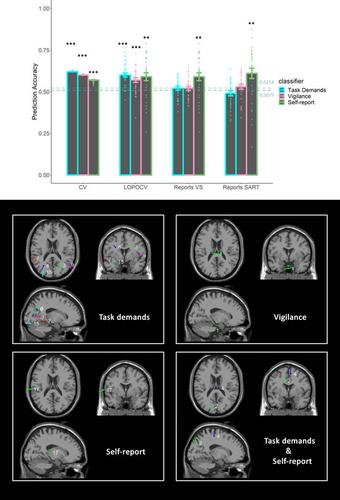当前位置:
X-MOL 学术
›
Eur. J. Neurosci.
›
论文详情
Our official English website, www.x-mol.net, welcomes your
feedback! (Note: you will need to create a separate account there.)
Distinguishing vigilance decrement and low task demands from mind‐wandering: A machine learning analysis of EEG
European Journal of Neuroscience ( IF 2.7 ) Pub Date : 2020-06-15 , DOI: 10.1111/ejn.14863 Christina Yi Jin 1 , Jelmer P. Borst 1 , Marieke K. Vugt 1
European Journal of Neuroscience ( IF 2.7 ) Pub Date : 2020-06-15 , DOI: 10.1111/ejn.14863 Christina Yi Jin 1 , Jelmer P. Borst 1 , Marieke K. Vugt 1
Affiliation

|
Mind‐wandering is a ubiquitous mental phenomenon that is defined as self‐generated thought irrelevant to the ongoing task. Mind‐wandering tends to occur when people are in a low‐vigilance state or when they are performing a very easy task. In the current study, we investigated whether mind‐wandering is completely dependent on vigilance and current task demands, or whether it is an independent phenomenon. To this end, we trained support vector machine (SVM) classifiers on EEG data in conditions of low and high vigilance, as well as under conditions of low and high task demands, and subsequently tested those classifiers on participants' self‐reported mind‐wandering. Participants' momentary mental state was measured by means of intermittent thought probes in which they reported on their current mental state. The results showed that neither the vigilance classifier nor the task demands classifier could predict mind‐wandering above‐chance level, while a classifier trained on self‐reports of mind‐wandering was able to do so. This suggests that mind‐wandering is a mental state different from low vigilance or performing tasks with low demands—both which could be discriminated from the EEG above chance. Furthermore, we used dipole fitting to source‐localize the neural correlates of the most import features in each of the three classifiers, indeed finding a few distinct neural structures between the three phenomena. Our study demonstrates the value of machine‐learning classifiers in unveiling patterns in neural data and uncovering the associated neural structures by combining it with an EEG source analysis technique.
中文翻译:

从游荡中区分警惕性下降和低任务要求:脑电图的机器学习分析
徘徊是一种普遍存在的心理现象,被定义为与正在进行的任务无关的自我生成的思想。当人们处于低警戒状态或执行非常简单的任务时,往往会出现思维游荡。在当前的研究中,我们调查了思维游荡是否完全取决于警惕性和当前的任务要求,或者它是否是一种独立的现象。为此,我们在低警惕性和高警惕性条件下以及在任务要求高低的条件下对支持向量机(SVM)分类器进行了训练,并随后在参与者自我报告的思维游荡中测试了这些分类器。参与者的间歇性精神探查方法测量了参与者的瞬时精神状态,并在其中报告了他们当前的精神状态。结果表明,警惕性分类器和任务需求分类器都无法预测高于机会水平的心理游荡,而经过心理游荡自我报告训练的分类器能够做到这一点。这表明,思维游荡是一种精神状态,与警惕性低或执行要求低的任务不同,这两者都可以与偶然性脑电图区分开。此外,我们使用偶极拟合对三个分类器中每个分类器中最重要特征的神经相关进行源定位,从而在这三种现象之间确实发现了一些不同的神经结构。我们的研究证明了机器学习分类器在揭示神经数据模式以及将其与EEG源分析技术相结合方面的价值,并揭示了相关的神经结构。
更新日期:2020-06-15
中文翻译:

从游荡中区分警惕性下降和低任务要求:脑电图的机器学习分析
徘徊是一种普遍存在的心理现象,被定义为与正在进行的任务无关的自我生成的思想。当人们处于低警戒状态或执行非常简单的任务时,往往会出现思维游荡。在当前的研究中,我们调查了思维游荡是否完全取决于警惕性和当前的任务要求,或者它是否是一种独立的现象。为此,我们在低警惕性和高警惕性条件下以及在任务要求高低的条件下对支持向量机(SVM)分类器进行了训练,并随后在参与者自我报告的思维游荡中测试了这些分类器。参与者的间歇性精神探查方法测量了参与者的瞬时精神状态,并在其中报告了他们当前的精神状态。结果表明,警惕性分类器和任务需求分类器都无法预测高于机会水平的心理游荡,而经过心理游荡自我报告训练的分类器能够做到这一点。这表明,思维游荡是一种精神状态,与警惕性低或执行要求低的任务不同,这两者都可以与偶然性脑电图区分开。此外,我们使用偶极拟合对三个分类器中每个分类器中最重要特征的神经相关进行源定位,从而在这三种现象之间确实发现了一些不同的神经结构。我们的研究证明了机器学习分类器在揭示神经数据模式以及将其与EEG源分析技术相结合方面的价值,并揭示了相关的神经结构。









































 京公网安备 11010802027423号
京公网安备 11010802027423号